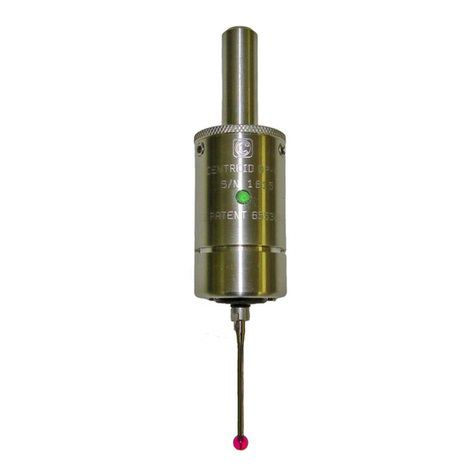
WHEN TO CHECK RUN-OUT:
Any time the pro e is removed from its holder, the stylus is changed or the pro e is used in a
different machine, the alignment procedure should e repeated to ensure accuracy. The user
should also repeat the alignment procedure if the unit receives any sudden external shock. It
is good practice to periodically check alignment for quality control and to esta lish a ase line
maintenance schedule.
ANGULAR ALIGNMENT:
Angular alignment is the relation of the spindle center line to the stylus stem center line. This
adjustment provides for equal clearance all around the stylus stem. This adjustment is rarely
needed except when an extremely small tip or long stylus is used. When the stylus tip and
stem are nearly the same diameter this adjustment is critical to keep the stem from contacting
a vertical surface efore the tip. This adjustment is also convenient to adjust parallelism when
flat disc or lock stylus types are used. The range of adjustment is very small as it is only
intended to correct the stylus and spindle center line alignment. If this adjustment must e
performed use the run-out adjustment set-up shown a ove to monitor the effect of the
adjustment. The angular alignment and run-out adjustments are interdependent. It will e
necessary to repeat each several times to achieve significant results. When completed, the
run-out at the stylus mount end of the stylus stem should e nearly the same as the run-out at
the tip. Adjust the stylus tip run-out last.
WHEN TO CHECK ANGULAR ALIGNMENT:
The DP-7 when shipped with a long stylus assem ly is aligned for that assem ly at the
factory. When replacing stylus assem lies with off the shelf parts it is likely adjustment will e
needed. Check the angular alignment any time stylus parts have een first assem led,
changed or adjusted.
CHECKING ANGULAR ALIGNMENT:
To check the angular alignment egin y checking run-out at the pro e tip. Adjust the tip run-
out to zero. Measure the run-out at the ase of the stylus stem (the end at the stylus mount
oss) with the dial indicator. If the run-out is greater than the difference etween the cali rated
tip diameter and stem diameter then it will e possi le for the stem to contact a vertical
surface efore the tip (also called “shanking out”). Adjustment is necessary if it is possi le for
the stylus to shank out.
Last Modified 2014-09-16 04:12:44 AM Page 7 of 21
C:\Users\Keith\AppData\Local\Temp\7zO0E521723\DP7 ody20140916.odt




























